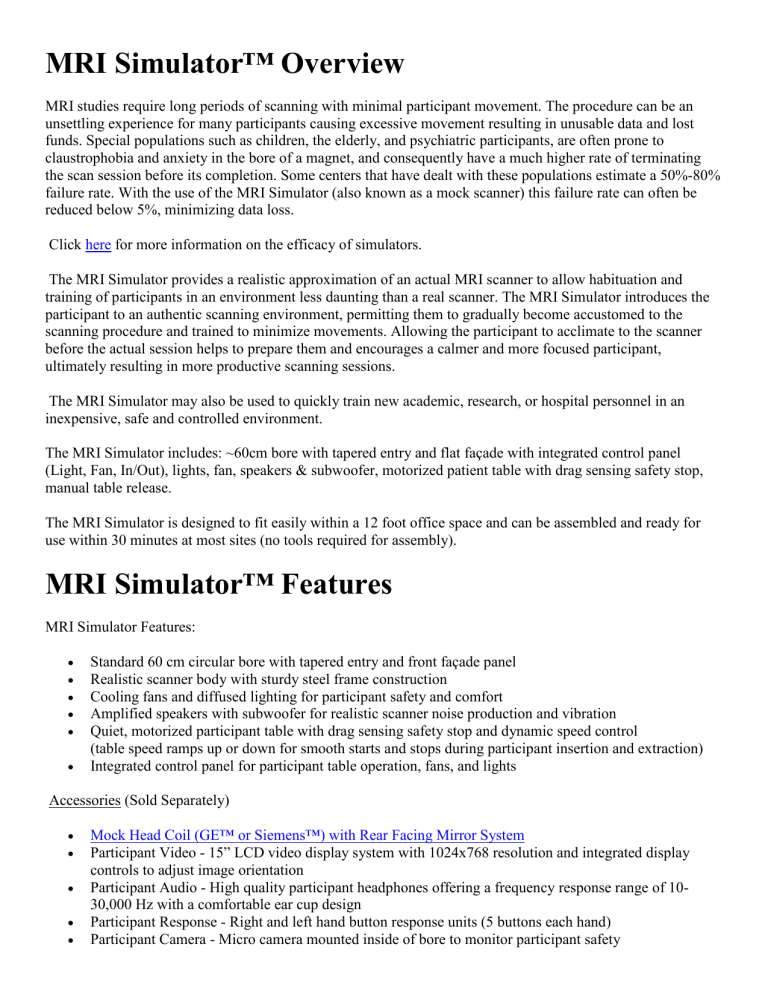MRI Simulator™ Overview

MRI Simulator™ Overview
MRI studies require long periods of scanning with minimal participant movement. The procedure can be an unsettling experience for many participants causing excessive movement resulting in unusable data and lost funds. Special populations such as children, the elderly, and psychiatric participants, are often prone to claustrophobia and anxiety in the bore of a magnet, and consequently have a much higher rate of terminating the scan session before its completion. Some centers that have dealt with these populations estimate a 50%-80% failure rate. With the use of the MRI Simulator (also known as a mock scanner) this failure rate can often be reduced below 5%, minimizing data loss.
Click here for more information on the efficacy of simulators.
The MRI Simulator provides a realistic approximation of an actual MRI scanner to allow habituation and training of participants in an environment less daunting than a real scanner. The MRI Simulator introduces the participant to an authentic scanning environment, permitting them to gradually become accustomed to the scanning procedure and trained to minimize movements. Allowing the participant to acclimate to the scanner before the actual session helps to prepare them and encourages a calmer and more focused participant, ultimately resulting in more productive scanning sessions.
The MRI Simulator may also be used to quickly train new academic, research, or hospital personnel in an inexpensive, safe and controlled environment.
The MRI Simulator includes: ~60cm bore with tapered entry and flat façade with integrated control panel
(Light, Fan, In/Out), lights, fan, speakers & subwoofer, motorized patient table with drag sensing safety stop, manual table release.
The MRI Simulator is designed to fit easily within a 12 foot office space and can be assembled and ready for use within 30 minutes at most sites (no tools required for assembly).
MRI Simulator™ Features
MRI Simulator Features:
• Standard 60 cm circular bore with tapered entry and front façade panel
• Realistic scanner body with sturdy steel frame construction
• Cooling fans and diffused lighting for participant safety and comfort
• Amplified speakers with subwoofer for realistic scanner noise production and vibration
• Quiet, motorized participant table with drag sensing safety stop and dynamic speed control
•
(table speed ramps up or down for smooth starts and stops during participant insertion and extraction)
Integrated control panel for participant table operation, fans, and lights
Accessories (Sold Separately)
•
•
Mock Head Coil (GE™ or Siemens™) with Rear Facing Mirror System
Participant Video - 15” LCD video display system with 1024x768 resolution and integrated display controls to adjust image orientation
• Participant Audio - High quality participant headphones offering a frequency response range of 10-
•
30,000 Hz with a comfortable ear cup design
• Participant Response - Right and left hand button response units (5 buttons each hand)
Participant Camera - Micro camera mounted inside of bore to monitor participant safety
Additional Options
• SimFx software simulates the ambient scanner sound and the active scanning noise. Four sound files can be played simultaneously.
• MoTrak head motion tracking system that provides linear feedback of X,Y,Z movement and rotational
• feedback on X,Y,Z axis (Pitch, Roll, Yaw coordinate) based on user-defined thresholds
E-Prime® experiment development and stimulus presentation software
MRI Simulator™ Requirements
• Minimum available room area of 12ft x 4ft (3.66m x 1.22m)
• Available power: 120V AC, 4 amps (240 volt model requires 2 amps)
• Line level audio signal for simulated scanner sounds
MRI Simulator™ FAQs
•
•
•
•
Q: How much space do I need for the MRI Simulator?
A: The MRI Simulator is designed to fit in standard sized office spaces. The specific sitting requirements will vary slightly by model and options, but the Standard model fits easily within a 12 foot office space. An optional compact participant table is also available which allows the unit to fit in a minimum 10 foot space (participant inserted/extracted with knees bent).
Q: Will I have to assemble the MRI Simulator myself?
A: The MRI Simulator is typically shipped as three independent sections (table, façade, bore) which will arrive on locking castors. The sections can be moved into position quickly and bolted together easily using the included illustrated assembly instructions (no tools are required for assembly). At most sites the entire unit may be assembled and ready for use within 30 minutes.
MRI Simulator™ Gallery
This product is intended for research use only.





